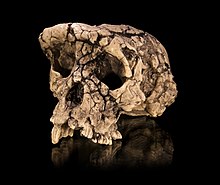Hominini
| Hominins Temporal range:
| |
|---|---|

| |
| Skull of Sahelanthropus tchadensis, considered by some researchers[according to whom?] to be the earliest fossil hominin. | |
| Scientific classification | |
| Domain: | Eukaryota |
| Kingdom: | Animalia |
| Phylum: | Chordata |
| Class: | Mammalia |
| Order: | Primates |
| Suborder: | Haplorhini |
| Infraorder: | Simiiformes |
| Family: | Hominidae |
| Subfamily: | Homininae |
| Tribe: | Hominini Gray, 1825 |
| Type species | |
| Homo sapiens Linnaeus, 1758
| |
| Genera | |
|
Subtribe Panina Subtribe Australopithecina Subtribe Hominina | |
Hominini is the tribe of Homininae that comprises Homo, and other members of the human clade after the split from the tribe Panini (chimpanzees).[1][2] Members of the tribe are called hominins (Template:Dabbr Hominidae, "hominids"). The subtribe Hominina is the "human" branch, including genus Homo. Researchers proposed the taxon Hominini on the basis of the idea that the least similar species of a trichotomy should be separated from the other two. Some earlier classification schemes include the genus Pan (chimpanzees) within the Hominini, but this classification is now rarely followed. Sahelanthropus tchadensis is an extinct hominid species that lived 7 million years ago, very close to the time of the chimpanzee / human divergence; it is thus unclear whether it can be considered a member of the Hominini tribe.
Through DNA comparison, scientists believe the Pan / Homo divergence occurred between 5.4 and 6.3 million years ago, after an unusual process of speciation that ranged over 4 million years.[3] Few fossil specimens on the Pan side of the split have been found, the first fossil chimpanzee discovery being published in 2005,[4] dating to between 545 ± 3 kyr (thousand years) and 284 ± 12 kyr via Argon-argon dating, from Kenya's East African Rift Valley. All of the extinct genera listed in the table to the right are ancestral to Homo, or are offshoots of such. However, both Orrorin and Sahelanthropus existed around the time of the split, and so may be ancestral to all three extant species.
In the proposal of Mann and Weiss (1996),[5] the tribe Hominini includes Pan as well as Homo, but within separate subtribes. Homo (and, by inference, all bipedal apes) is in the subtribe Hominina, while Pan is in the subtribe Panina. Wood (2010) discusses the different views of this taxonomy.[6]

See also
- History of hominoid taxonomy
- List of human evolution fossils (with images)
References
- ^ Bradley, B. J. (2006). "Reconstructing Phylogenies and Phenotypes: A Molecular View of Human Evolution". Journal of Anatomy. 212 (4): 337–353. doi:10.1111/j.1469-7580.2007.00840.x. PMC 2409108. PMID 18380860.
- ^ Wood and Richmond.; Richmond, BG (2000). "Human evolution: taxonomy and paleobiology". Journal of Anatomy. 197 (Pt 1): 19–60. doi:10.1046/j.1469-7580.2000.19710019.x. PMC 1468107. PMID 10999270.
- ^ "Human and chimp genomes reveal new twist on origin of species". [ EurekAlert!/AAAS]. 2006-05-17.
{{cite web}}: Missing or empty|url=(help) - ^ McBrearty, Sally and Nina G. Jablonski (2005). "First fossil chimpanzee". Nature. 437 (7055): 105–108. Bibcode:2005Natur.437..105M. doi:10.1038/nature04008. PMID 16136135.
- ^ Mann, Alan and Mark Weiss (1996). "Hominoid Phylogeny and Taxonomy: a consideration of the molecular and Fossil Evidence in an Historical Perspective". Molecular Phylogenetics and Evolution. 5 (1): 169–181. doi:10.1006/mpev.1996.0011. PMID 8673284.
- ^ B. Wood (2010). "Reconstructing human evolution: Achievements, challenges, and opportunities". Proceedings of the National Academy of Sciences. 107: 8902–8909. Bibcode:2010PNAS..107.8902W. doi:10.1073/pnas.1001649107.
